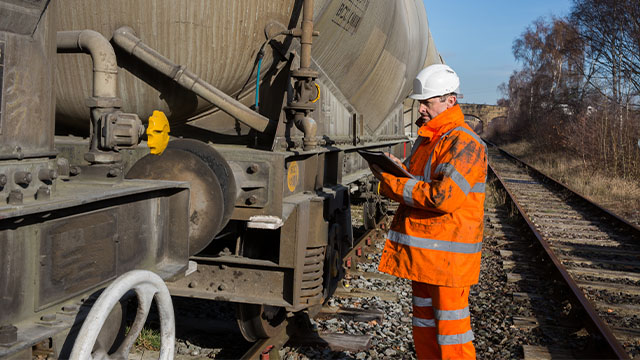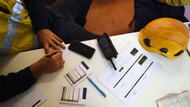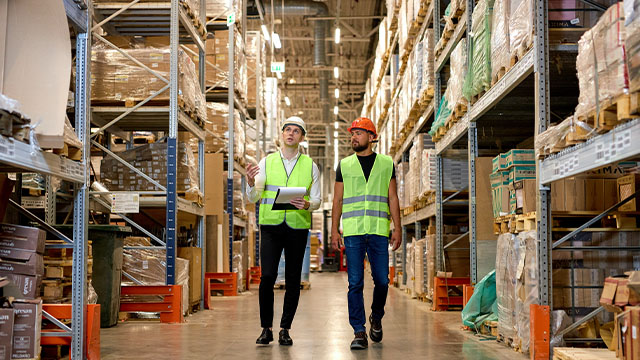Nothing beats the reliability of a Safe Work Method Statement (SWMS) when ensuring workplace safety during high-risk work activities. It outlines the risks associated with a specific task and provides steps to carry out the work safely. It also serves as a record of workers' consultation and helps identify potential hazards in advance.
However, creating a SWMS can be time-consuming and challenging, especially for businesses with multiple high-risk activities. That's where SWMS templates come in. These pre-made templates provide a framework for creating comprehensive and compliant SWMS. It simplifies the process, ensuring all necessary precautions are taken to keep workers safe.
Purpose of a SWMS
A SWMS is an administrative control supporting higher-order controls to minimise health and safety risks. It differs from some other specific documents like a Job Safety Analysis or Safe Operating Procedures. Some purposes of a SWMS include:
Safety Planning
SWMS helps in carrying out high-risk construction work safely. For example, construction work such as excavations, demolitions, and working at heights may involve hazards that every person responsible must address. It helps supervisors, workers, and other persons at the workplace understand the established safety requirements. It clearly outlines the procedures everyone follows in carrying out a task safely.
Compliance
By outlining how to reduce risk in a particular work activity, SWMS helps employers fulfil their legal duties of caring for workers' safety. They must prepare an SWMS for the 18 most high-risk construction work outlined by WHS Regulations. Failure to have a Safe Work Method Statement in place can result in significant fines and legal action.
Communication
SWMS are a communication tool between supervisors, workers, and other stakeholders. It ensures everyone knows the hazards and risks associated with a particular task and how to mitigate them. This promotes a culture of safety, where everyone takes responsibility for their actions and works together to create a safe working environment.
Training and Induction
SWMS also plays a crucial role in training workers on proper safety procedures. They provide detailed instructions on how to carry out a task safely, including any necessary personal protective equipment (PPE) and emergency response procedures. By regularly reviewing and updating the SWMS, employers can ensure that workers are trained on the most current safety measures.
Risk Management
By identifying potential hazards and establishing control measures, SWMS allows for effective risk management in the workplace. Employers can use a SWMS to assess tasks before they are carried out and determine any potential risks, allowing for implementing preventative risk control measures beforehand. This protects workers' safety and well-being and minimises the risk of workplace accidents and injuries.
What is a Safe Work Method Statement Template?
Since a SWMS is a crucial document for any high-risk workplace environment, using a template can be a great way to save time. A SWMS template is a customisable document that outlines the safety procedures for a particular task or activity. It includes details such as relevant hazards and risk assessments, safety policies, control measures, roles and responsibilities of workers, and any other relevant information.
These pre-made documents provide step-by-step guidance on completing a SWMS. They come pre-filled with essential sections like scope, hazards, control measures, and monitoring —simplifying the creation process. Document providers, such as SafetyDocs offer SWMS templates for various industries and will make safety easier to manage.
Who Prepares the SWMS?
To ensure safety in high-risk construction work, a Person Conducting a Business Undertaking (PCBU) must prepare the SWMS or confirm its preparation. The SWMS should be in place before commencing such work. While other construction tasks may not need a SWMS, a PCBU must effectively mitigate health and safety risks. A principal contractor must also acquire the SWMS before starting high-risk construction work.
Can you create your own SWMS?
Yes, you can. While a template is recommended for efficiency and accuracy, it is not mandatory. You can create your own SWMS from scratch if it includes all the necessary information and follows the relevant safety regulations and requirements. However, creating a SWMS from scratch requires in-depth knowledge of safety procedures.
So, why not save time and effort using a template that safety experts have designed?
Benefits of Using a SWMS Template
Time-saver
Imagine writing each separate SWMS from scratch. The process can take time if multiple tasks or activities are involved. A template simplifies the process and helps get things done quickly, as most sections are already pre-filled.
Consistency
Using the same template for all tasks helps ensure that all SWMSs have the same structure and look. This makes it easier to compare and identify discrepancies. When all templates are consistent, it's easier to track and identify areas of improvement. It's also a great way to ensure everyone is on the same page.
Manageability
A template lets you focus on the content rather than worrying about the format. Using a template ensures that all relevant information is in the proper order. Tracking your safety with a template you can update regularly is more manageable.
Cost-efficient
Using a safe work method statement template can help you save on costs because you don't need to hire a consultant or document preparer. It also helps avoid duplication of effort and keeps tracking expenses low.

Key Elements of SWMS Templates
The template should be simple, concise, and easy for everyone in the workplace to understand. Incorporating the vital elements into the template will help ensure the document effectively identifies and mitigates workplace risks. A SWMS must include the following:
1. List of high-risk construction work
This is a list of the high-risk construction work activities in your workplace that you must prepare for a SWMS, i.e., demolition, excavations, and working at height. This includes the workplace location relevant to the high-risk activities.
2. Job or task description
The SWMS should have a description of the work, including the location, equipment, and materials required. It should also include the total number of personnel involved, and any other relevant information. Every stage of the task should also be included in the document.
3. Identification of hazards
This is a critical step in the SWMS process. Begin by brainstorming all potential hazards associated with the task and work environment. It's essential to involve workers in this process, as they have direct experience with potential hazards on the job site.
4. Workplace-specific risk assessment
The risk assessment includes an evaluation of the likelihood and consequence of the identified hazards. This is an assessment of the level of risk associated with each hazard, including the probability and consequences of an incident occurring.
5. Control measures
Control measures are vital components of a SWMS. Select and implement controls based on the specific hazards identified, following this hierarchy:
- Elimination: Wherever possible, completely remove the hazard from the work process.
- Substitution: Replace the hazard with a less dangerous material, process, or piece of equipment.
- Engineering Controls: Implement physical barriers or systems to isolate workers from the hazard (e.g., machine guards, ventilation).
- Administrative Controls: Modify work practices, provide training, implement safe work procedures, or use clear warning signage to reduce risk.
- Personal Protective Equipment (PPE): Use appropriate PPE (e.g., gloves, respirators, eye protection) as a last line of defence.
Remember, the controls must address the specific hazards identified. Involve workers in this process to ensure the selected controls are practical and effective.
6. Names and signatures
Include the names and signatures of subcontractors, workers, principal contractors, health and safety representatives, and persons conducting business undertakings (PCBUs) following the SWMS. This will ensure that all parties have read and understand the document before work commences. The SWMS must identify the people who participated in developing and implementing the SWMS.
Best Practices for Developing Your SWMS
Consult with health and safety representatives and workers.
Ask them for their experiences and feedback about hazards relating to the work that will be carried out. They are the ones who interact with the equipment and machines, and they know better about potential hazards. Consult affected workers to help identify risks and come up with a safety plan that is feasible and practical to implement. This helps identify potential risks that can be avoided or reduced by implementing specific controls (such as using protective equipment, providing adequate training, etc.)
Train workers on the SWMS.
It is essential to ensure that everyone understands and can follow the contents of a SWMS. Ensure your workers have safety training to complete tasks according to the SWMS safely and can identify and address any risks that may arise during the job.
Review the SWMS
Once the SWMS is complete, reviewing it with the safety representatives and everyone involved is essential. Ensure that all workers know what is expected of them, that the SWMS is up-to-date, and that all hazards are addressed. After the review process, sign off on the SWMS and store it in a safe place.
Revise the SWMS as needed.
As work on the construction project progresses, review the contents of the SWMS periodically to ensure that all identified risks are adequately managed. Make sure to update and sign off on the SWMS any time there is a change in the work that may increase risk.
SafetyDocs For Every SWMS Template You Need
Ready to get started on your SWMS? SafetyDocs by SafetyCulture is here to help. We have many customisable safety document templates that meet regulatory requirements and cover many topics, including construction SWMS. You can start by browsing our most popular SWMS templates and customising them to meet the needs of your work environment:
- Earthmoving Equipment Safe Work Method Statement: Working with equipment like skid-steerers, backhoes, bulldozers, or a powered mobile plant can be dangerous. This template covers the safe operation of these machines and the use of protective equipment, hazard identification, and control measures.
- Silica Dust Safe Work Method Statement: This template covers the safety measures needed when working with these materials. Silica dust can cause severe lung diseases, and it is essential to have a proper risk management plan in place when working with it.
- Height Access Equipment Safe Work Method Statement: This SWMS template covers the safety precautions when using height access equipment, including harnesses and ladders, to prevent falls and other accidents. It also covers the proper inspection and maintenance of equipment before use.
- Forklift Safe Work Method Statement: This template is a must for any workplace that uses forklifts. This template covers the safety precautions that should be taken when operating these machines.
- Manual Handling Safe Work Method Statement: This SWMS template covers the safe and proper way to lift heavy objects and use mechanical aids such as trolleys or hoists.
- Confined Space Work Safe Work Method Statement: This template covers the safety measures to take when working in confined spaces. It discusses emergency plans, rescue procedures, and protective equipment.
- Painting and Decorating Safe Work Method Statement: When working with hazardous materials, following the proper safety procedures, such as when painting, is critical.
- Demolition Safe Work Method Statement: Construction projects often involve demolishing buildings or parts of buildings. Be ready for any demolition project with this template.
- Roof Work Safe Work Method Statement: Activities such as inspecting, repairing, and installing roofs can be dangerous. Make sure you are ready with this template.
- Tiling Safe Work Method Statement: This template covers the safety precautions needed when installing tiles, such as using protective equipment and maintaining the correct posture.
We have more SWMS templates available so you can ensure that all your safety needs are met. Use a template for each task and revise it as needed. Contact us today to learn more about our safe work method statement templates, or discover SWMS for your workplace using the finder below!
Our team of experts is dedicated to providing accurate and informative content. Craig Cruickshank, our senior HSEQ advisor at SafetyDocs by SafetyCulture has reviewed this blog post to ensure the highest level of quality.
Learn more about Craig's work on LinkedIn for more industry insights.
Available for instant download and supplied in fully editable MS Word format for use in your business.
Please note that the above information is provided as a comment only and should not be relied on as professional, legal or financial advice.
Share This Article

